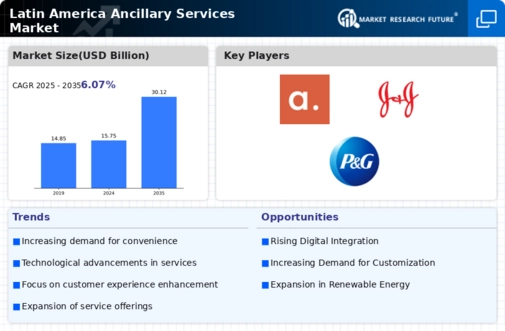Market Trends
Key Emerging Trends in the Latin America Ancillary Services Market
The Latin America ancillary services market has been witnessing notable trends and developments, reflecting changing consumer preferences, airline industry dynamics, and technological advancements. One significant trend in the Latin America ancillary services market is the increasing focus on ancillary revenue generation by airlines as a means to boost profitability in an increasingly competitive landscape. Ancillary services, which include offerings such as baggage fees, seat selection, onboard meals, and priority boarding, have become a vital source of revenue for airlines, accounting for a significant portion of their total income. Airlines in Latin America are leveraging innovative pricing strategies, bundling options, and dynamic pricing algorithms to optimize ancillary sales and maximize revenue per passenger, thereby enhancing their financial performance and competitiveness in the market.
Moreover, there is a growing demand for personalized and premium ancillary services among travelers in Latin America, driven by rising disposable incomes, changing lifestyles, and evolving consumer expectations. Airlines are responding to this trend by diversifying their ancillary offerings to include a range of value-added services such as lounge access, inflight entertainment upgrades, Wi-Fi connectivity, and expedited security screening. By catering to the needs and preferences of discerning travelers, airlines can enhance the overall travel experience, increase customer satisfaction, and differentiate themselves in a crowded marketplace, ultimately driving loyalty and repeat business.
Additionally, the Latin America ancillary services market is witnessing a shift towards digitalization and technology adoption to streamline ancillary sales processes, enhance operational efficiency, and improve the passenger experience. Airlines are investing in advanced reservation systems, mobile apps, and self-service kiosks to enable passengers to conveniently purchase ancillary services at various touchpoints throughout their journey, including during booking, check-in, and onboard. By leveraging digital channels and automation, airlines can reduce reliance on traditional distribution channels, minimize overhead costs, and provide passengers with greater flexibility and control over their travel experience.
Furthermore, there is a growing trend towards ancillary partnerships and collaborations between airlines and third-party service providers in Latin America, aimed at expanding ancillary offerings and enhancing the overall value proposition for passengers. Airlines are forging strategic alliances with hotel chains, car rental companies, travel agencies, and retail brands to offer bundled packages, cross-promotional deals, and loyalty program benefits that incentivize ancillary purchases and drive incremental revenue. These partnerships not only enable airlines to diversify their revenue streams but also provide passengers with access to a wider range of services and amenities, enriching their travel experience and fostering brand loyalty.
Another notable trend in the Latin America ancillary services market is the increasing adoption of ancillary revenue management systems and analytics tools to optimize pricing, inventory management, and distribution strategies. Airlines are leveraging data-driven insights and predictive analytics to forecast demand, identify revenue opportunities, and tailor ancillary offerings to individual customer segments and market conditions. By adopting a dynamic pricing approach and personalized marketing tactics, airlines can maximize ancillary revenue potential, mitigate revenue dilution, and achieve greater revenue per available seat kilometer (RASK), contributing to overall profitability and business growth














Leave a Comment